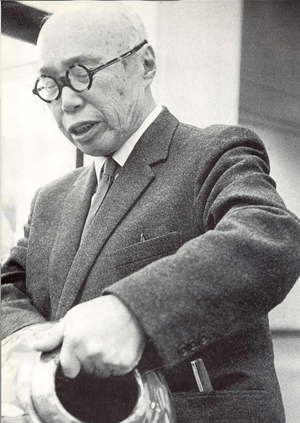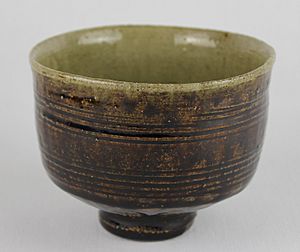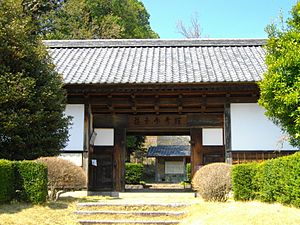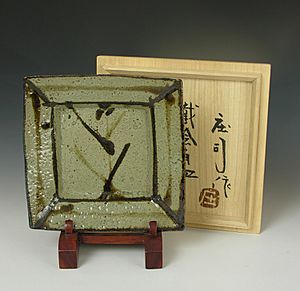Shōji Hamada facts for kids
Shōji Hamada (born December 9, 1894 – died January 5, 1978) was a famous Japanese potter. He greatly influenced how pottery was made in the 1900s. Hamada was also a key person in the mingei movement, which celebrated everyday folk art. He helped make the town of Mashiko a world-famous place for pottery. In 1955, Japan named him a "Living National Treasure" for his amazing skills.
Contents
Early Life and Training
Hamada was born in Kawasaki, Japan, in 1894. He went to Hibiya High School, which was a very good school. After that, he studied ceramics at the Tokyo Institute of Technology.
Learning Pottery Skills
At the Tokyo Institute, he studied with Kawai Kanjirō and Itaya Hazan. Hamada and Kawai were the only students who wanted to become artist-potters. They quickly became friends. They explored the city together, looking for new ideas.
They also worked together in Kyoto. There, they experimented with different glazes. Glazes are the shiny coatings on pottery. They used various minerals to create new colors and textures. During this time, they met Yanagi Sōetsu and Tomimoto Kenkichi.
Meeting Bernard Leach
Hamada was very impressed by an art show in Tokyo. It featured ceramic art by Bernard Leach. Leach was a British potter who was visiting Japan. Hamada wrote to Leach to meet him.
The two potters found they had a lot in common. They became good friends. In fact, Hamada asked to go with Leach back to England in 1920. Leach wanted to start a pottery workshop there, and Hamada joined him.
Pottery in Mashiko
Hamada spent three years in St Ives, England, with Bernard Leach. He returned to Japan in 1923. He traveled around, visiting different pottery places. He even stayed in Okinawa for several weeks.
Setting Up Shop
Eventually, Hamada decided to set up his own workshop in Mashiko. This town is about 100 km (62 miles) north-east of Tokyo. He built his own pottery studio there. He made a rule for himself: he would only use materials found nearby.
This meant using local clay for his pots. He also made his own glazes from local minerals. Even his brushes were handmade from dog hair and bamboo. This showed his strong connection to the local area.
A Living National Treasure
In 1955, the Japanese government gave Hamada a special title. They called him a "Living National Treasure." This was the first time someone from the world of crafts received this honor. It meant his skills were very important to Japanese culture.
Supporting Folk Art
Hamada was very keen on the folk art movement in Japan. This movement, called mingei, celebrated beautiful everyday objects made by ordinary people. After Yanagi Muneyoshi, a leader of the movement, passed away in 1961, Hamada became the second director of the Japanese Folk Crafts Museum.
In 1977, Hamada opened his own museum at his home. It is now called the Shoji Hamada Memorial Mashiko Sankokan Museum. He displayed his collection of folk crafts from Japan and other countries there.
Helping Young Potters
Hamada was very supportive of young artists. Many moved to Mashiko to learn from him. These included his student Shimaoka Tatsuzō and Kamoda Shōji. Hamada also helped make Mashiko a popular place for tourists. He even offered homes and workshops for potters visiting from other countries.
Hamada passed away in Mashiko on January 5, 1978.
Preserving Old Buildings
When Hamada moved to Mashiko, he started buying old buildings. These were traditional farmhouses, stone warehouses, and gatehouses. They were from the Edo period and special to southern Tochigi Prefecture. He moved them to his property and fixed them up.
His first old building was his own home in 1930. He used other buildings as workshops and places to host guests and students. His last workshop was set up in 1942. In 1989, his home was moved to the Mashiko Museum of Ceramic Art. It was recognized as an important cultural building. Today, visitors can still see Hamada's studio and his collections at the museum.
Hamada's Impact
Hamada spent his life making pottery. He became famous all over the world. Museums everywhere have collected his works. His influence was strong in Japan, especially in Mashiko. But it also reached potters in the West, like in the United Kingdom and the United States.
His style and ideas became well known among studio potters. He was seen as a perfect example of an "Oriental" potter. Today, Hamada's pottery sells for high prices. You can see some of his work at the York Art Gallery in the UK.
Awards and Honors
Hamada received many important awards for his work:
- Minister of Education Prize in 1952
- Living National Treasure in 1955
- Medal of Honor, Purple Ribbon in 1964
- Order of Culture in 1968
He also received special degrees:
- Honorary degree in arts from the Royal College of Art
See also
In Spanish: Shōji Hamada para niños





